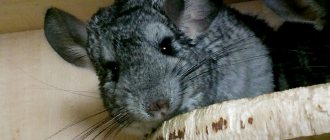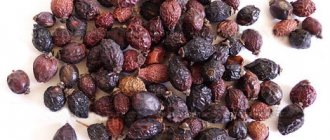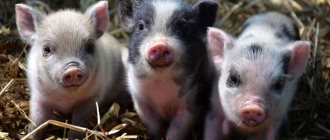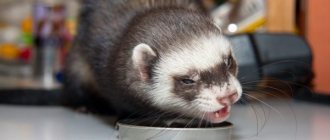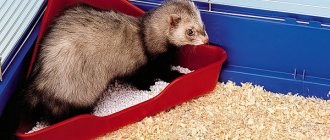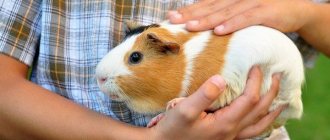Under favorable conditions, ferrets live 8-10 years and practically do not get sick. But sometimes animals experience partial or complete loss of hair, which often starts from the tail. This phenomenon does not always pose a threat to the health of the ferret and often does not require veterinary intervention. Let's find out why ferrets go bald and how to deal with this problem.
Common reasons
Baldness of any part of a ferret's body can occur for various reasons. Among the most common are:
- molting period;
- clogged pores on the skin;
- emotional stress;
- lack of a balanced diet;
- deficiency of vitamins;
- period of sexual desire;
- the period of gestation, childbirth and lactation in females;
- age-related changes;
- room temperature is too high;
- influence of parasites;
- lack of grooming;
- diseases - dermatitis, scabies, harmful insects, pathologies in the adrenal glands, weakened immunity.
Next, let's look at each reason in more detail.
Moulting period of animals
Ferrets shed twice during the year. The first time this period lasts from the second half of February to the second half of March. The second time molting occurs in August and can continue until the end of autumn. The period of fur renewal in animals depends on the length of daylight hours.
Often the coat change begins with the tail. Sometimes these changes occur unnoticed by others, since the old fur is quickly replaced by new ones. Sometimes the coat becomes shaggy because the old coat has not yet fallen out, but the new undercoat has already appeared. In this case, the pet owner can help his pet by regularly combing the fur with a special brush. Brushing reduces the risk of developing lice and fleas.
Sometimes ferrets experience a phenomenon called focal baldness. This is a normal physiological condition in furry animals that live in regions with hot summer climates. In this case, with the help of alopecia, it becomes easier for the animal to regulate its body temperature. Most often, in this case, the tail completely peels off.
Important! If your ferret's hair has fallen out due to seasonal shedding, then there is no need to do anything. Soon the fur will grow back. This is a common occurrence and does not pose any threat to the life of the animal.
Flu in ferrets
Ferrets are susceptible to the influenza virus that affects humans. An animal can also become infected with the disease from another ferret, often during the incubation period. Symptoms for the flu are classic: severe runny nose, cough, fever, lacrimation, and often unstable stools. For the next 3-5 days, the animal practically does not eat, moves little, and sleeps a lot in order to overcome the disease. Young ferrets are most affected by the flu and usually require medical attention.
If you have the flu, your ferret should be seen by a doctor to prevent pneumonia.
Adult ferrets often cope with the virus on their own within a few days to two weeks. If the flu becomes complicated and does not go away, the veterinarian will prescribe treatment. Doses are selected only by a specialist, taking into account weight, condition, and the presence of symptoms of the disease. Young pets are almost always treated with antibiotics, but have a high mortality rate due to influenza.
Table No. 1. Flu medications for ferrets.
Name of the drug Group Feature Amoxicillin Antibiotic Sometimes provokes hypoglycemia Tavegil Antihistamine Given only once a day, despite the instructions Suprastin Antihistamine Given no more than twice a day, despite the instructions Cephalotin Antibiotic With caution in case of diseased liver and damaged kidneys Anandin Nasal drops Universal drug, can also be treated for rhinitis Chamomile decoction Anti-cough It is recommended to infuse warm at least three times a day Chest collection Anti-cough It is recommended to infuse warm at least three times a day Nurofen Antipyretic Given only at a really high temperature, it has an additional analgesic effect Baytril Antibiotic Has a negative effect influence on the bone apparatus
Only a doctor can prescribe pills for your ferret.
Contamination of pores on the epidermis
Often, focal baldness in ferrets occurs due to clogged pores. This problem can be caused by the following factors:
- hormonal changes during the period of sexual desire or gestation;
- uncleanliness of the animal; the ferret does not properly care for its fur.
If the pores are clogged, you can see it. In those areas where there is no fur, black or brown dots are visible. If the skin condition is advanced, scabs are visible instead of dots. In order to normalize the animal's epidermis, it is necessary to perform several hygiene measures.
Special scrubs are purchased at a specialized point of sale. You can also make this cosmetic product yourself. To make it, you will need the following components in equal parts - almonds, sour cream and oatmeal. Everything is mixed and ground in a blender. Next, the skin is treated daily until it becomes clean again.
There is a second option for cleansing the skin, it is more budget-friendly. Take laundry soap, grate it, dilute it with water to make a paste. Using an old toothbrush, apply this product to the desired areas and smoothly and gently rub into the skin. After this, the product must be washed off with water.
What you can do on your own
If the baldness of the tail is associated with molting, then it must be combed out to prevent the falling hair from getting into the animal’s intestines and forming unsightly clumps.
A ferret's tail becomes bald even after experiencing stress. Stress for an animal is a change in habitat or the lack of a secluded place where it can hide. To prevent your pet from going completely bald, you should help him build a hole where he can hide. You can also put different pebbles in the box so that he can dig into them.
The health and beauty of a ferret's coat directly depends on proper nutrition. The diet must certainly contain meat, fish, chicken eggs and cheese. Meat should be given to the ferret with various cereals, chicken eggs should be boiled, and hard cheese should be pampered as a delicacy. The optimal solution in choosing the right diet would be to consistently switch the animal to dry, balanced food.
To maintain a beautiful and shiny coat, it must be brushed regularly.
If the causes of baldness are associated with clogged pores, then to clean them, the ferret can apply ordinary laundry soap to the skin with a soft toothbrush. You can also make your own herbal scrub (mix ground almonds and oatmeal with sour cream) and treat your skin with it several times until it is completely cleansed.
If your ferret is losing its fur and is constantly itching and biting itself, it most likely has fleas. In this case, it must be treated with a special preparation.
To prevent hair loss, you can give your pet special vitamins for the coat. It will only be better if they are selected by a specialist. If you cannot overcome baldness for more than a month, you should take the animal to the veterinarian.
Emotional shock
Baldness in ferrets can occur due to severe stress or boredom. These predators need to be provided with the opportunity to be active and constantly move. When in a cramped cage and a sedentary lifestyle, the animal may experience severe melancholy, this cannot but affect its well-being and physical condition.
Other causes of baldness due to stress include excessively loud sounds and excessively strong odors. You cannot spray air fresheners in the room where the animal lives. Also, there should not be a TV, computer or other sources of loud sounds here. If you plan to renovate the house, the cage should be moved to the quietest room.
The animal may experience severe stress due to the fact that the cage does not have a house in which it can hide for the night. In their natural environment, these predators hide in minks. Therefore, they need to build a small shelter in the form of a house in which they can sleep peacefully. The house should be warm, with a round entrance. It is recommended to place a soft foam mat on the bottom.
Hair loss can also be a reaction to an inability to move freely. Therefore, ferrets need to be released from their cage periodically. The cage itself must be spacious so that the animal can frolic and move freely around it.
Loneliness can cause stress, so it is better to keep such animals in pairs. Another cause of stress could be another ferret's aggressive behavior. A change in living conditions, a change of cage, or a new place can also have a depressing effect.
All these negative factors that affect the animal’s well-being and physical condition can be eliminated by humans. It is enough to organize a shelter for your pet, provide a free area for games, silence for relaxation, and exclude contacts with aggressive animals.
How to deal with baldness
If your ferret is going bald, the first thing to do is determine the cause of the baldness. If it is physiological, you can try to help your pet. So, when shedding, in order to prevent the animal’s fur from getting into the stomach, it must be combed out. To avoid stressful situations, do not raise your voice at the animal, equip a house and often walk with it in the fresh air.
If you have the slightest suspicion of a serious illness, you should never treat your ferret yourself. This should be done by a veterinarian.
Lack of a balanced diet
The condition of a ferret's fur is directly related to how balanced their diet is. If the menu does not contain enough nutrients, the coat begins to fade and the fur begins to fall out. This is accompanied by dry skin and itching. To get rid of this problem, you need to adjust your diet. The required products that must be included are:
- offal;
- boiled chicken, turkey meat;
- fish;
- boiled eggs;
- vegetables – fresh or boiled;
- cheese;
- vegetable fats;
- fish flour;
- porridge.
You cannot feed your pets food from the table. You cannot give them sausage, smoked meats, or food intended for cats or dogs. Such products negatively affect the condition of the coat.
To solve the problem, it is recommended to purchase professional food that contains a sufficient amount of vitamins, micro- and macroelements. You also need to add the above products to the menu. To improve the condition of the coat, the veterinarian may advise giving the animal multivitamin complexes.
Hormonal imbalance
In males, changes in hormonal levels occur during the period of sexual desire. This is accompanied by hair loss. This is observed in females when they are bearing offspring. These processes are physiological and do not require specialist intervention. After the end of these periods, the hormonal levels return to normal, the coat restores its previous condition.
During this period, the male becomes extremely agitated, aggressive and irritable. It begins to mark the territory, the production of sebum increases, as a result of which the fur becomes greasy and smells unpleasant.
The ferret becomes inactive, loses appetite and body weight, and may chew on the bars of the cage. If mating of adults does not occur, this condition in the male may continue until the onset of winter. To solve this problem, your veterinarian may recommend castration of your pet. This must be done before the first year.
Life activity of parasites
If the conditions of detention are violated and there is a lack of necessary hygiene, ferret owners may encounter problems such as skin parasites in their pets. Therefore, it is very important to detect parasites on your pet’s fur in a timely manner. The most common parasites that may appear are lice, nits and fleas.
Fleas can be found much less frequently than on other pets. The main symptoms of their vital activity are severe itching, the appearance of areas without fur, scabs and papules. The development and reproduction of parasites is accompanied by anemia and slower growth of the animal.
To get rid of parasites, it is necessary to use chemicals. They must be used strictly according to the instructions if the animal’s body weight has reached 500 grams and is at least six months old. Such products should not be applied to a female who is bearing offspring. To prevent the development of parasites, it is recommended to carry out regular preventive treatment, at least once every six months.
Can fleas pass to humans?
In particularly advanced situations, insects can be found throughout the home, including on humans. The insects will bite and cause an unpleasant itch, especially for those people who are sensitive to insect infestation. As a rule, bite marks appear in the leg area, primarily in the ankle area. If the bite site is scratched, a secondary infection may enter the body.
Remember, you are responsible for those you have tamed, take care of your pet, devote as much time to it as necessary! The above methods will help cure your pet or completely avoid the appearance of fleas in your home.
Infection with ectoparasites is one of the most common problems in pets. Most owners do not distinguish between these annoying insects, highlighting mainly only the flea. What are the features of these ectoparasites and what consequences will the presence of insects on the body of an animal entail? Let's consider these questions.
Allergic reaction
It is not uncommon for ferrets to develop an allergic reaction to food, grooming products, or other irritants. In this case, the animal becomes bald, it develops severe itching, and there is redness and peeling of the epidermis.
The most common causes of an allergic reaction are:
- intestinal dysbiosis;
- use of antibacterial drugs;
- contact with household chemicals;
- the use of cosmetics to care for the cage and bedding;
- products for treating toys and bathing pets.
If an allergy is diagnosed, then it is important to exclude contact with the irritant.
In what cases should you contact a veterinarian?
In case of diseases of the adrenal glands, seeking help from a specialist is necessary when the first signs of illness appear in your ferret. If the animal is going bald, itching, behaving aggressively, going into prolonged estrus or rutting, or experiencing pain when urinating, then you need to hurry while there is still hope for recovery.
After surgical treatment, the ferret recovers quite quickly. After a week, the fur begins to grow and after a month the fur becomes the same.
You should consult a doctor if you cannot restore the animal’s fur on your own within a month.
Other diseases
Baldness in ferrets can occur with the development of more serious diseases. In the absence of hair, a veterinarian can determine the following diagnosis after a preliminary examination:
- insulinoma - the body itches, the animal focuses its gaze on one object, drags its paws. It is almost impossible to get rid of this disease;
- eczema – accompanied by the appearance of weeping, bare, flaky areas on the animal’s body, the disease is very difficult to treat;
- fungal pathologies - accompanied by the appearance of inflamed bald patches on the skin;
- neoplasia – neoplasms in the body of animals;
- endocrine pathologies.
Allergy
The ferret began to itch outside of the molting period, but there are no fleas on its body? Perhaps it's an allergy. Three main elements of a ferret’s everyday life can be a breeding ground for allergens:
- Stern. Dyes are often added to cheap food, which can be rejected by the body. This reaction causes itching and severe scratching.
- Tray fillers. Chemicals are added to the mixture so that they can effectively combat the smell of animal urine and feces. Upon contact with moisture, the chemical evaporates and gets on the animal’s skin, causing a rash and severe itching. The animal can comb the problem area until it bleeds.
- Often the allergen is detergents for frets. For this reason, all bathing practices should be reduced to a minimum.
To determine what exactly has become an allergen, eliminate one potential breeding ground for allergens at a time. Change the food - it didn’t help, the tray filler - the same result, the detergent - the animal stopped itching. This is done simply and without harm to the animal. Have you noticed that such a replacement did not give anything? It's better to contact a specialist. The veterinarian will do a couple of tests, and you will already know exactly the causes of allergic itching.
This reason cannot be called serious, unlike the next one.
Adrenal damage
Animals older than three years of age may develop adrenal disease. It is accompanied by baldness. Reasons also include castration and sterilization of young animals too early, and increasing the length of daylight hours using artificial lighting.
The main signs of the development of a pathological process in the adrenal glands are:
- symmetrical alopecia;
- loss of appetite in the animal;
- lethargy and inactivity of the animal;
- thinning hair;
- thinning of the epidermis, the appearance of ulcerations;
- severe itching on the body;
- pronounced musky aroma that comes from skin and wool;
- increased sexual activity in the male;
- swelling of the external genitalia in sterilized females;
- difficulty emptying the bladder in males due to an enlarged prostate gland;
- weakness of the hind limbs;
- increased thirst;
- loss of body weight.
The method of therapy is determined by the age category of the animal, its well-being, and the severity of the pathological process. The most common methods used in therapy are:
- the use of hormonal drugs - in this case, the animal is given a capsule with a hormonal drug;
- surgical treatment - the doctor removes the affected adrenal gland from the sick animal;
- Combination therapy – consists of using several methods.
With timely assistance, it is possible to prolong the ferret’s life and return the condition of its coat to its previous form.
Loss of hair on the tail and body, accompanied by severe itching of the skin
As a rule, when the ferret wakes up, he begins to groom himself after waking up, and then begins to play. If the animal suddenly stops playing, exploring the surrounding space and begins to itch, this is a signal of possible health problems, especially in cases where this is accompanied by loss of fur.
First of all, it is necessary to examine the ferret's integument for the presence of ectoparasites - lice, ticks, lice eaters, fleas. These uninvited guests not only irritate your pet’s skin, but are also carriers of dangerous infectious and invasive diseases.
To get rid of ectoparasites, ferret fur is treated three times with insectoacaricidal preparations at seven-day intervals. After this course of treatment, medications are applied that repel external parasites.
Loss of fur with severe itching indicates the presence of exoparasites in your pet.
Today, there are a large number of such drugs on the market with various commercial names, so when choosing, you should pay close attention to which active ingredient is used in the product you are purchasing. Better yet, if you notice that your ferret is itching too often and intensely, consult a veterinarian.
Today, there are a large number of such drugs on the market with various commercial names, so when choosing, you should pay close attention to which active ingredient is used in the product you are purchasing. Better yet, if you notice that your ferret is itching too often and intensely, consult a veterinarian.
Tick activity
Hair loss in a ferret can occur if it is attacked by the itch mite. The main symptoms of the appearance of the parasite include:
- alopecia areata;
- peeling of the epidermis;
- the appearance of purulent discharge on the affected areas;
- loss of appetite and body weight.
If timely treatment is not carried out with prescribed drugs, the development of the disease ends in death.
Otodectes mites can also develop in ferrets' ears. Its activity is accompanied by severe itching, black discharge, loss of appetite, and inactivity of the pet. If the disease is not treated, the animal will completely lose its hearing. Therapy is carried out after the appointment of a veterinarian. In addition to treating the wool, it is necessary to instill specially selected drops into the ear canal.
Loss of hair on the tail and body, accompanied by severe itching of the skin
As a rule, when the ferret wakes up, he begins to groom himself after waking up, and then begins to play. If the animal suddenly stops playing, exploring the surrounding space and begins to itch, this is a signal of possible health problems, especially in cases where this is accompanied by loss of fur.
First of all, it is necessary to examine the ferret's integument for the presence of ectoparasites - lice, ticks, lice eaters, fleas. These uninvited guests not only irritate your pet’s skin, but are also carriers of dangerous infectious and invasive diseases.
To get rid of ectoparasites, ferret fur is treated three times with insectoacaricidal preparations at seven-day intervals. After this course of treatment, medications are applied that repel external parasites.
Loss of fur with severe itching indicates the presence of exoparasites in your pet.
Today, there are a large number of such drugs on the market with various commercial names, so when choosing, you should pay close attention to which active ingredient is used in the product you are purchasing. Better yet, if you notice that your ferret is itching too often and intensely, consult a veterinarian.
Neoplasms
With benign or malignant degeneration of tissues of internal organs, a tumor appears in the animal’s body. Typically, the growth of such a formation occurs slowly, accompanied by the following symptoms:
- dulling of fur, dishevelment;
- alopecia areata, which starts from the tail and spreads to the rest of the body;
- thinning of the epidermis in the area of baldness;
- severe weight loss of the animal.
It is important to recognize the disease in time and conduct a comprehensive diagnosis. Treatment consists of surgery. Doctors also prescribe treatment with chemotherapy drugs.
Mycosis
Mycosis of the skin develops under the influence of a fungus. The pathogen reproduces by spores and affects the hair and epidermis of animals. Next, fungal spores grow into the epidermis and spread to adjacent areas of the skin.
The basis of the parasite's nutrition is keratin, which is present in the epidermis and hair. At first, redness is visible, severe itching, baldness appears, and the animal is constantly itching.
Important! If there are abrasions or scratches on the body, the infection spreads faster.
The source of infection is a sick animal, lack of proper standards for keeping the ferret, and insufficient hygiene. The incubation period lasts about a month. Then the following signs of the development of fungal processes occur: alopecia, excessive dryness of the epidermis, severe itching and flaking.
Therapeutic measures consist of removing the affected areas of fur to stop the further development of the disease, treating the epidermis with antifungal ointments prescribed by the doctor. In advanced cases, the doctor prescribes antibacterial drugs and oral antifungals. The duration of treatment is usually one month.
Khrumik.ru - Pododermatitis: a disease of hamster feet
Pododermatitis is a disease of the skin with subcutaneous tissue, foot bones in rodents, looks like corns. The skin of the feet begins to flake off, peel, become covered with crusts, and in advanced cases, bleed and fester. In fact, this is a bacterial infection that primarily affects the hind legs, and less often the front legs.
Why does pododermatitis happen?
Reasons contributing to the development of corns:
- Physical inactivity. Being kept in a small cage and forced inactivity, including rare walks, means that the hamster will have to be treated not only for corns, but also for other serious diseases.
- Excess weight. The load on the paws and bones increases, which is a consequence of improper feeding and physical inactivity.
- Incorrect sharpening of claws. If the hamster is kept on a smooth surface and does not wear down its claws, they will grow too long and change the normal angle of the limb, increasing the load on the hock joint. It is recommended to have a running wheel with a solid surface.
- Age. Older hamsters are prone to developing pododermatitis.
- Traumatic surfaces. If balls, wheels, gratings, ladders have burrs, cracks, sharp protrusions, they stimulate the inflammatory process in the constantly injured area of the paw.
- Skin diseases. Injuries, skin parasites, allergies are manifested by an inflammatory process.
The wild ancestors of hamsters are constantly on the move; they have the ability to grind their claws down while moving on various surfaces (sand, grass, stones, clay). On soft soils, the claws sink deep into the soil, and the weight load is evenly distributed over the entire foot, while hard surfaces do not allow the claws to grow.
On linoleum and wooden floors, the claws do not sink deep, and the area of support is reduced by moving them to the “heel.” Due to increased load, the skin is compressed, which leads to the development of inflammation, impaired blood supply, and pain.
Pathogenic microflora, bacteria, and fungi settle and multiply in inflamed skin, provoking an acute inflammatory response in the body.
Stages of development of pododermatitis
- Superficial lesion. The prognosis is favorable, self-healing is possible.
- Infection of superficial layers. As long as bacteria do not penetrate deeper, the prognosis is favorable with timely treatment.
- Penetration of microorganisms.
Treatment is required, the prognosis is cautious towards favorable, but the disease may recur in the future. - Deep penetration.
The skin, subcutaneous tissue, and tendon apparatus are affected, and treatment is only possible surgically, with a cautious prognosis towards the unfavorable.
How to treat pododermatitis
Pododermatitis can be treated for a long time, with the local use of special sprays and powders. In particular, foreign veterinarians use Intracell, Amerigel, Granulex, Silvadene. Our veterinarians recommend Terramycin spray, Vagotil.
Be sure to change the conditions of detention. The hamster's cage needs to be replaced with a plywood pen so that he cannot climb on the bars. The pen can be placed on a countertop that is free of scratches and cracks, and covered with white, odorless and pattern-free paper towels.
Newspapers are not allowed, as printing inks contain lead and toxic additives. You can run in a wheel, but the running surface must be relatively smooth. There should be no remains of grain feed, sawdust, or any plant litter under the hamster’s paws.
The food should be placed in a deep small bowl so that the hamster cannot rummage through it with sore paws.
Antibiotics do not lead to the desired result, and microorganisms can even develop resistance to them.
Terramycin spray and Vagotil are applied to the affected area 2 times a day, isolating the treatment area (hold the hamster in your arms) for 15 minutes. The average treatment period takes a month - 40 days. You can use dietary supplements and homeopathy at the same time.
Vitamin deficiency
If animals do not have the required amount of vitamin H in their bodies, hypovitaminosis develops. The result of the development of the disease is damage to the epidermis. If there is not enough biotin in the body, this is a consequence of the animal eating raw chicken proteins too often. This product interferes with the absorption of biotin by the body. The main signs of the disease are an inflammatory process on the surface of the epidermis, the development of seborrhea, alopecia and severe itching.
To get rid of the pathological process, the doctor prescribes multivitamin complexes to the animal, which contain biotin. You should also include foods with a high content of this vitamin in your diet.
Swelling of the legs as a symptom of pathological conditions and diseases
Swelling caused by a physiological cause is usually symmetrical, that is, it is observed on both legs at once. Such swelling is usually mild; If you press with your finger, a mark remains at the point of pressure, which disappears right before your eyes. When physiological conditions are restored to normal, edema quickly disappears. The absence of these signs, especially if the swelling does not go away within 24 hours, is a reason to consult a doctor: in this case, the swelling is most likely caused by a pathological cause.
The list of diseases, the manifestation of which can be swelling of the legs, is extensive. Here are the main ones:
